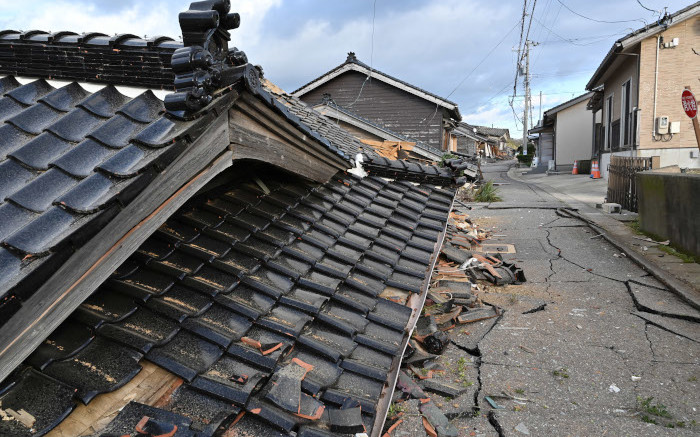
The magnitude 7.5 quake that struck Ishikawa Prefecture on the main island of Honshu unleashed tsunami waves more than a meter high, sparked a major fire and ripped apart streets.
Collapsed wooden houses are seen in Wajima, Ishikawa Prefecture, Jan. 2, 2024, a day after a massive 7.5-magnitude earthquake struck the Noto region of Ishikawa Prefecture in the afternoon. Image: Kazuhiro NOGI/AFP
WAJIMA – Japanese rescuers battled against time and powerful aftershocks on Tuesday to find survivors of a New Year’s Day earthquake that killed at least 50 people and caused widespread destruction.
The magnitude 7.5 quake that struck Ishikawa Prefecture on the main island of Honshu unleashed tsunami waves more than a meter high, sparked a major fire and ripped apart streets.
On the Noto Peninsula, buildings were destroyed, houses were leveled, fishing boats were sunk or washed ashore and highways were hit by landslides.
“I’m amazed that the house is so broken and everyone in my family made it out unscathed,” Akiko said as she stood in front of her parents’ crooked house in the hard-hit town of Wajima.
The start of 2024 “will remain in my memory forever,” she told AFP after what she called a long and violent earthquake on Monday.
“It was such a violent jolt,” said Tsugumasa Mihara, 73, as he lined up with hundreds of others to get water in the nearby town of Shika.
Japan’s Kyodo news agency put the death toll at 57, citing local officials, as rescuers combed through the rubble.
“Very extensive damage has been confirmed, including numerous casualties, building collapses and fires,” Prime Minister Fumio Kishida said after a disaster relief meeting.
“We must race against time to search for and rescue victims of the disaster.”
Aerial footage showed the frightening extent of a fire that ripped through the old market area of Wajima, collapsing a seven-story commercial building there. The earthquake damage affected rescue efforts to put out the fire.
Kyodo said most of the houses in the coastal city of Suzu collapsed.
“The situation is devastating as about 90 percent of the houses are completely or almost completely destroyed,” Suzu Mayor Masuhiro Izumiya told a prefectural government meeting.
Nearly 33,000 homes were without power in the region and temperatures reached freezing overnight, the local utility said. Many cities had no running water.
According to the US Geological Survey, the quake had a magnitude of 7.5. Japan’s meteorological agency recorded a reading of 7.6 and said it was one of more than 210 to hit the region by Tuesday evening.
Several strong jolts were felt early Tuesday, including one with a magnitude of 5.6 that prompted national broadcaster NHK to switch to a special broadcast.
“Please take a deep breath,” the host said, reminding viewers to check for fires in their kitchens.
Tsunami warning lifted
Waves at least 1.2 meters (four feet) high hit Wajima on Monday, and a number of smaller tsunamis were reported elsewhere.
Warnings of much larger waves proved unfounded and on Tuesday Japan lifted all tsunami warnings.
Images on social media showed cars, houses and bridges shaking violently in Ishikawa while frightened people cowered in shops and train stations.
Houses collapsed and large cracks appeared in streets, while others were hit by landslides. Meteorologists warned that rainfall could further loosen the soil on slopes.
A team of firefighters crawled under a collapsed commercial building in Wajima looking for survivors, television footage showed.
“Keep up! Hold on,” they shouted as they fought their way through stacks of wooden beams with an electric saw.
The Wajima fire reportedly engulfed up to 200 buildings, with people evacuated in the dark, some with blankets, others with babies.
A Wajima Fire Department official said authorities were overwhelmed with rescue operations and reports of damage on Tuesday.
Ishikawa Governor Hiroshi Hase wrote on social media that roads in large parts had been cut off by landslides or cracks, while “several” ships had capsized in Suzu port.
According to local media, Suzu’s mayor called the damage in the city “catastrophic,” saying 1,000 houses there had been completely destroyed and 4,000 to 5,000 residents could no longer live in their homes.
High-speed trains suspended
Monday’s quake shook homes in the capital Tokyo, about 300 kilometers (186 miles) away, where a public event welcoming New Year’s Day by Emperor Naruhito was canceled.
Around 1,400 people were stuck on hanging high-speed trains overnight, including Georgian Ambassador Teimuraz Lezhava, who praised the “kindness of the station staff and passengers around us” on social media.
Around 1,000 others were stuck on local express trains for nearly 24 hours after they were stopped on Monday, NHK said.
About 500 people were also stranded at the damaged Noto airport, with access roads blocked and the runway full of cracks.
Japan experiences hundreds of earthquakes every year, most of which cause no damage.
The number of earthquakes in the Noto Peninsula region has increased steadily since 2018, according to a Japanese government report last year.
The country was hit by a massive 9.0 magnitude underwater earthquake off northeastern Japan in 2011, triggering a tsunami that left about 18,500 people dead or missing.
It also flooded the Fukushima nuclear power plant, causing one of the world’s worst nuclear disasters.
According to the Japanese Atomic Energy Agency, no abnormalities were reported at the Shika nuclear power plant in Ishikawa or other facilities following the recent quake.
China joined the United States and other countries on Tuesday to express condolences.






Recent Comments